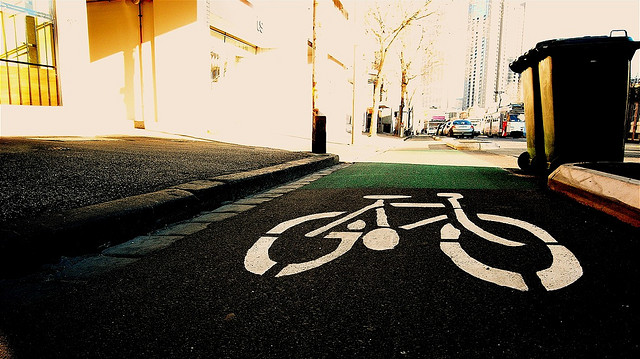The City of Melbourne’s Bike Plan is well under way with construction of a bike lane currently making its way up La Trobe Street. The council’s four year plan to make Melbourne a ‘cycling city’ includes creating a safe and connected network that encourages participation in cycling.
The Melbourne City Council is set to spend $5 million to increase cycling in the city, building on existing infrastructure by adding 15 kilometers of new bike lanes and trails. The plans include a number of high priority on-road cycling routes such as La Trobe Steet, Princess Bridge on Swanston Street, St Kilda Road, Elizabeth Street, Exhibition Street and Clarendon Street.
The plan is to the delight of cycling lobby groups who have been campaigning for safer infrastructure.
The council seeks to fix biking black spots and improve transitions from off-road to on-road paths. Improved links will be created at precincts including The Yarra Trail through Alexandra Gardens, Queen Victoria Gardens to St Kilda Road as well as the Docklands and Royal Park Routes. Better end-of-trip facilities and more bicycle parking will also be a focus.
In La Trobe Street a separate bicycle lane removed from car traffic by an island is being inserted. In Elizabeth Street a peak-period bike lane between Flinders and La Trobe Street will allow ease of access to the city for cyclists using the Capital City Trail.
City of Melbourne CEO, Kathy Alexander affirms the ability to feel safe and comfortable as the key to a ‘cycling city’. “Although numbers continue to grow, there is still more that needs to be done if we are to realise our target of more than 122,000 daily bicycle trips by 2016,” said Alexander.
Each weekday about 80o,000 people travel to the City of Melbourne to work, study or visit. By 2016 this is set to increase to 900 thousand. At present most of these trips are made by car.
The council is committed to increasing biking trips to, from and within by 50 per cent. By 2016 a 15 per cent change in the number of local trips (under 7km) from car and public transport to bicycles is envisioned, along with 15 per cent of all vehicles entering the central city during morning peak to be bicycles.
The current top six suburbs for commuting to the city by bike are Northcote, Brunswick, Fitzroy North, Kensington, Coburg and Hawthorn. The City of Melbourne sees increased use of bicycles easing congestion and public transport pressure.
Less experienced cyclists will be encouraged to cycle more under the plan. Research and bicycle safety campaigns will be implemented to boost participation and monitor changes and trends.
As Melbourne continues to grow, biking will inevitably become an important commuting method for many in the city. A commitment by government to safe and plentiful infrastructure will support and encourage biking as a serious mode of transport.
Matt O’Leary


